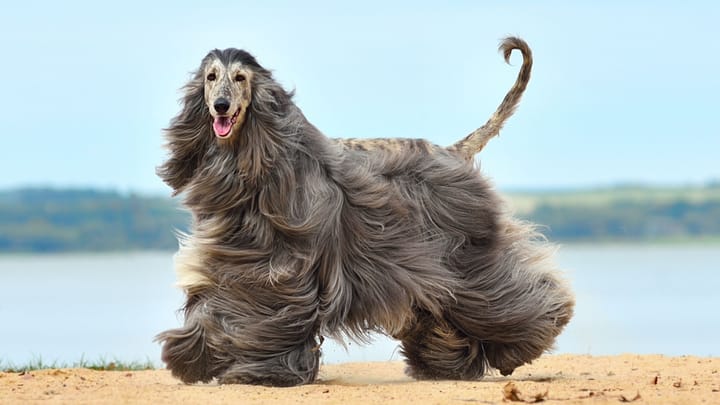Afghan Hound
Other names : Tazhi Spay, Baluchi Hound, Ogar Afgan, Barakzai Hound, Eastern Greyhound, Persian Greyhound


One of the oldest pure breeds of dogs, the ancient Afghan Hound has remained unchanged in its appearance for centuries. It has a very long and fine silky coat and was bred to hunt large and small game in the mountains of Afghanistan without human leadership. It was introduced into the United Kingdom in the 1800s.
|
Life expectancy |
The Afghan Hound has a life expectancy of between 12 and 14 years |
|
Temperament |
|
|
Size |
Large
|
|
Adult size |
Female
Between 25 and 27 in
Male
Between 27 and 29 in
|
|
Adult weight |
Female
Between 55 and 66 lb
Male
Between 55 and 66 lb
|
|
Coat colour
The coat of the Afghan can be of any colour including fawn, gold and blue. It may also be brindled. Many dogs of the breed have a black facial ‘mask’: the dark colour of the fur on their muzzle and head gives the impression of a mask. |
Black White Brown Blue Red Sand |
|
Type of coat
The hair is long. The Afghan’s single coat is fine and silky and similar to human hair. The dog is covered in abundant fur and usually has a silky topknot on its head. |
Long |
|
Eye colour
Dark brown, sometimes golden. |
Brown
|
|
Purchase price |
The Afghan Hound costs between £515 and £940 |
The Afghan Hound gets stressed and agitated very easily. When it becomes so the dog may refuse to move from where it is (even if it is in the middle of a road); it may also urinate indoors or fall asleep very suddenly.
More details about the Afghan Hound
Afghan Hound: Origins and history
The Afghan originated in Afghanistan several centuries (some say millennia) ago. It is an ancient pure dog breed that has remained relatively unchanged in that time. During the 1800s Afghan Hounds were brought to the United Kingdom by army officers who returned from active service in what was then British India (including the countries of Afghanistan and Persia). The Afghan used to be called the Persian Hound.
Physical characteristics of the Afghan Hound
A dog with a regal appearance is the Afghan. Its head is held high and proud and its body is agile and built for speed. The tail is carried low but raised when the dog is moving. The limbs are graceful, sloped and reasonably muscular. The ears are low and hang close to the head.
FCI classification of the Afghan Hound
-
Group 10 - Sighthounds
-
Section 1 : Long-haired or fringed Sighthounds
Afghan Hound: Characteristics
Afghan Hound: Behaviour
Training a Afghan Hound
The Afghan Hound is reasonably difficult to train. Its independence and aloofness can mean that it refuses to learn to be obedient. Couple this refusal with the dog’s inability to learn quickly and retain lessons and you have a difficult student to say the least. The Afghan is not overly motivated by food and treats which can make training especially taxing. Patience and an awareness of the dog’s limitations can lead to a degree of obedience, although nothing should be taken for granted.
Afghan Hound: Lifestyle
Breed compatibility Afghan Hound
Afghan Hound: Purchase price
The price for an Afghan Hound can vary according to his age, gender and origins. But you could count on average £940 for a dog registered with the KC.
The average monthly budget ranges from £150 and £175 in order to fully meet the needs of the Afghan Hound.
Afghan Hound: Shedding
Light
Afghans do not shed their hair as much as other breeds.
Afghan Hound: Grooming
Daily brushing is required to prevent the Afghan’s hair (which is similar in texture to human hair) from becoming tangled and matted. Several times a year the dog should be professionally clipped. The dog should also be bathed regularly. An ear inspection every week is essential for this long-eared dog: mites, fleas and fungi find the Afghan’s ear very inviting.
Afghan Hound: Health
12 to 14 years.
The Afghan Hound is an active and adventurous dog but it is not a robust breed.
The coat of the Afghan Hound allows the dog to be more tolerant of hot temperatures than most. You must still make sure there is plenty of fresh water on hand for this dog. Do not leave ANY dog in a car in the summer, even if you have parked in the shade.
The Afghan Hound is also reasonably tolerant of the cold. Care should be taken after cold and wet walks to dry the dog’s coat thoroughly.
Weight gain is not usually a feature of the Afghan. However, if an Afghan is not exercised as regularly as it should be and is fed too much human or substandard food it will become obese.
- Allergies
- Bloat
- Cancer
- Cataracts
- Chylothorax
- Dilated Cardiomyopathy
- Hip Dysplasia






